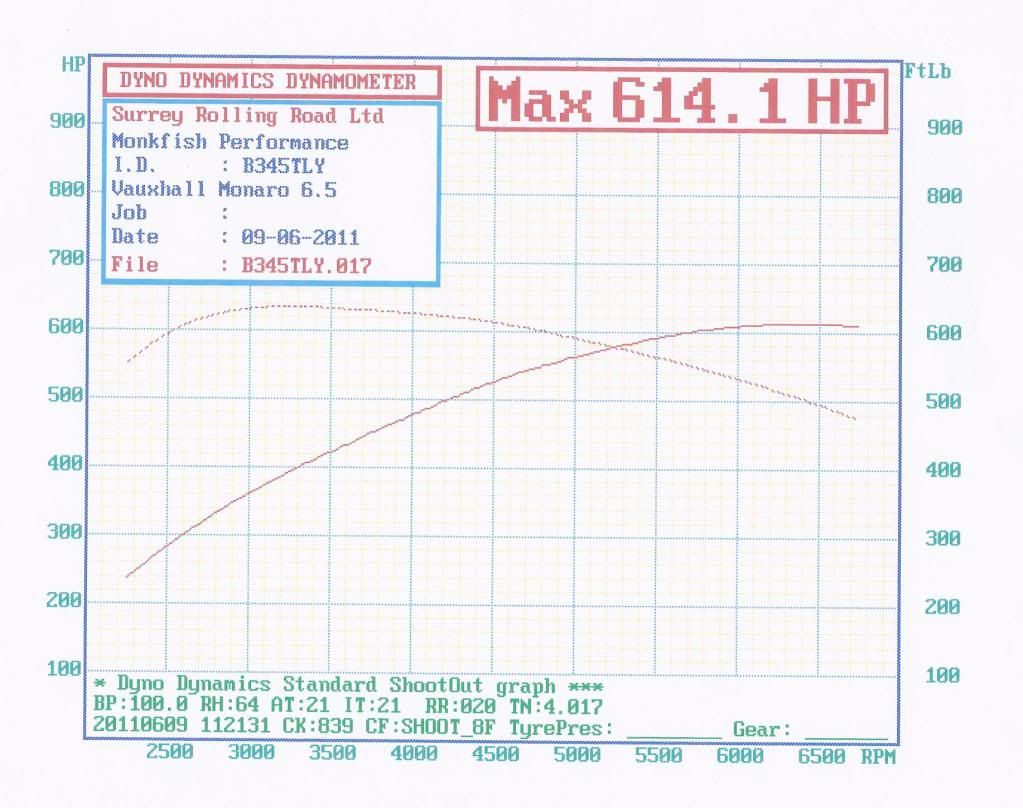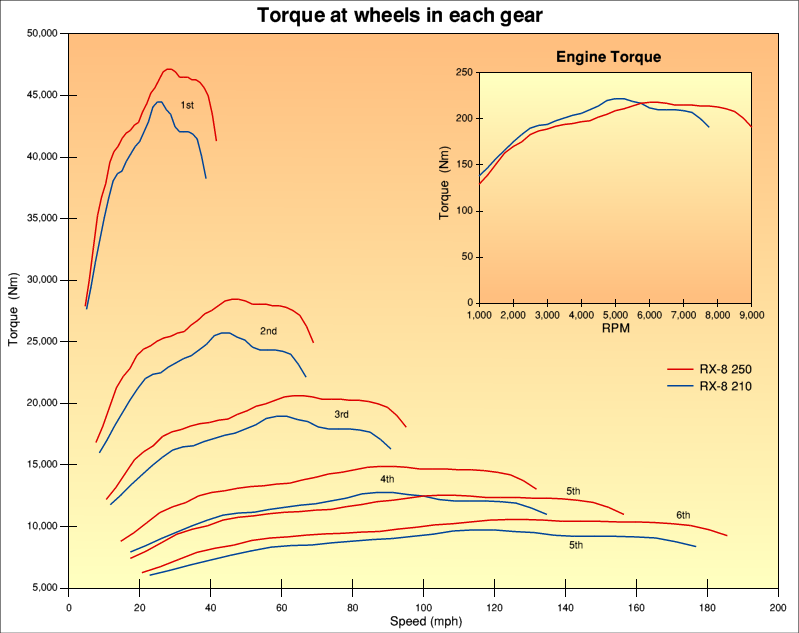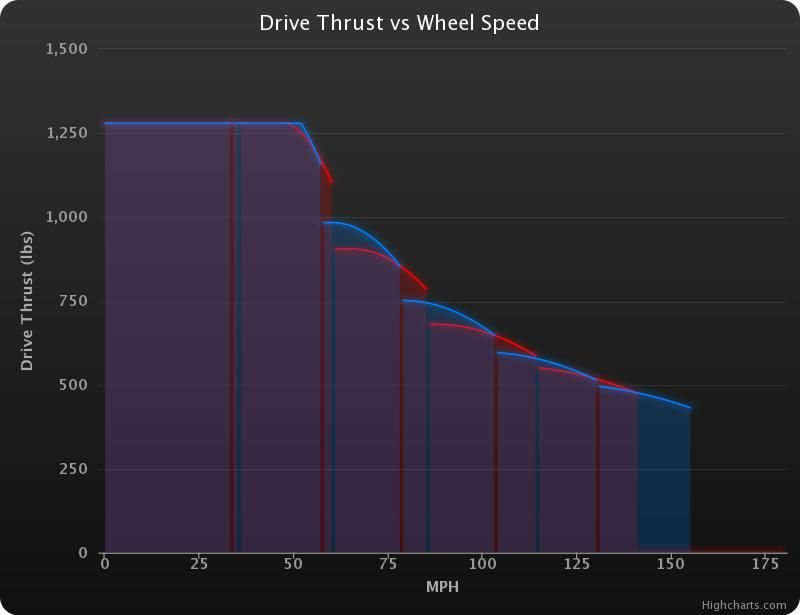Question about BHP + Torque
Discussion
wormus said:
Speedy11 said:
Sorry I know why, but I don't think wormus knows why cars have a gearbox or how one works.
I think we are discussing different things. In the 2 dyno graphs I posted both for my car, one has 800 S_HP (flywheel HP) and 921 ft-lbs. The other shows 614 HP (wheel HP) and 640 ft-lbs. Really not sure where 281 lbs have gone unless one is flywheel TQ and the other is wheel TQ. Both done in 4th gear, same diff, same gearbox and same engine. Really not sure why you are going on about gearboxes.Edited by Mave on Monday 28th July 23:35
Edited by Mave on Tuesday 29th July 00:07
wormus said:
I think we are discussing different things. In the 2 dyno graphs I posted both for my car, one has 800 S_HP (flywheel HP) and 921 ft-lbs. The other shows 614 HP (wheel HP) and 640 ft-lbs. Really not sure where 281 lbs have gone unless one is flywheel TQ and the other is wheel TQ. Both done in 4th gear, same diff, same gearbox and same engine. Really not sure why you are going on about gearboxes.
Becuase you don't understand that the overall gear ratio effects wheel rpm and wheel torque and for the 2nd time your graph doesn't show torque at the wheels.Mave said:
And the thing you are calling "wheel torque" doesn't actually exist as a physical phenomena - its actually the equivalent torque you would need at the flywheel to get the measured power at the wheels if there were no losses.
Read this a couple of times and realised what you were saying, never thought of it but makes sense, cheers.There's a chap on You Tube who does some decent videos on car engineering. He has one just on power vs torque but I rather like this F1 vs Nascar one as recommended viewing for anyone that thinks torque is about acceleration and power is about top speed
https://www.youtube.com/watch?v=CxK0x7AE3s8&li...
Compulsory viewing for diesel fans who like to explain how they have more torque than a [insert supercar name] or quote some specific superior in gear acceleration time that relies on said supercar being in completely the wrong gear.

https://www.youtube.com/watch?v=CxK0x7AE3s8&li...
Compulsory viewing for diesel fans who like to explain how they have more torque than a [insert supercar name] or quote some specific superior in gear acceleration time that relies on said supercar being in completely the wrong gear.
Speedy11 said:
Becuase you don't understand that the overall gear ratio effects wheel rpm and wheel torque and for the 2nd time your graph doesn't show torque at the wheels.
4th gear in my car is 1:1 so your argument is invalid. If the 2nd graph does not show wheel torque at 640lbs what does it show? It's not flywheel torque as that's a calculated 921lbs.wormus said:
4th gear in my car is 1:1 so your argument is invalid. If the 2nd graph does not show wheel torque at 640lbs what does it show? It's not flywheel torque as that's a calculated 921lbs.
But you still have a diff which will be ~3 so tripling the torque and the cutting the RPM by a third. And have you ever thought that dynos lie?Speedy11 said:
wormus said:
4th gear in my car is 1:1 so your argument is invalid. If the 2nd graph does not show wheel torque at 640lbs what does it show? It's not flywheel torque as that's a calculated 921lbs.
But you still have a diff which will be ~3 so tripling the torque and the cutting the RPM by a third. And have you ever thought that dynos lie?Like this:

Speedy11 said:
wormus said:
4th gear in my car is 1:1 so your argument is invalid. If the 2nd graph does not show wheel torque at 640lbs what does it show? It's not flywheel torque as that's a calculated 921lbs.
But you still have a diff which will be ~3 so tripling the torque and the cutting the RPM by a third. And have you ever thought that dynos lie?wormus said:
And I say again, what you seem to be referring to is tractive effort instead of wheel power and torque. From Google "Tractive effort is the force being applied at the tread of the tyres and is proportional to engine torque. It differs from torque because it takes into account the gearing of the drivetrain (gearbox, final drive and tyre diameter). Power runs are usually conducted in second or third gear, and the tractive effort graph can be plotted against either engine rpm or road speed at the wheels."
I am really not because if I were I would have mentioned tyre circumference/radius.Simply put
Torque at wheels is the result of engine torque and the gearing ie gearbox and diff
Tractive effort is the result of torque at the wheels and the size of the tyre.
Mr2Mike said:
Don't be daft. How could a car move without a torque being applied to the driven wheels?
Read my post again. I didn't say wheel torque doesn't exist. I said the thing he is calling wheel torque doesn't exist. Because I don't think the graph actually shows torque at the wheel,Mave said:
Mr2Mike said:
Don't be daft. How could a car move without a torque being applied to the driven wheels?
Read my post again. I didn't say wheel torque doesn't exist. I said the thing he is calling wheel torque doesn't exist. Because I don't think the graph actually shows torque at the wheel,
At 7000rpm it makes 614 wheel horsepower = 461*7000/5252. 461 lbs of what if not wheel torque?
wormus said:
Mave said:
Mr2Mike said:
Don't be daft. How could a car move without a torque being applied to the driven wheels?
Read my post again. I didn't say wheel torque doesn't exist. I said the thing he is calling wheel torque doesn't exist. Because I don't think the graph actually shows torque at the wheel,
At 7000rpm it makes 614 wheel horsepower = 461*7000/5252. 461 lbs of what if not wheel torque?
This really does seem to baffle some people. Here is a short derivation which hopefully might help people understand. Do let me know if I've made any mistakes.
Engine Instantaneous Torque (Nm) = Te
Engine Instantaneous Power (kW) = Pe
Engine Instantaneous Speed (Rads/s) = ωe
Engine and Flywheel Rotational Inertia (kgm2) = Ie
Gearbox Ratio = Gr (0.1 = 10 engine revolutions per output revolution)
Final Drive Ratio = Dr
Drivetrain Inertia (kgm2) = Id
Wheel Inertia (kgm2) = Iw
Wheel Rotational Acceleration (Rads/s^2) = Ar
Wheel Radius = Rw
Wheel Torque = Tw
Wheel rotational velocity = ωw
Vehicle Total Mass (kg) = M
Vehicle Acceleration (m/s^2) = Al
Total rotational inertia referred to wheels:
I_r = (4 * I_w + I_d / D_r + I_e / (G_r * D_r))
Newton’s second law of motion:
F = MA
Relationship between torque and angular acceleration:
A_r = T_e / I_r
Rotational velocity is related to linear velocity by:
V_l = R_w * V_r
And hence rotational acceleration is related to linear acceleration by:
A_l = R_w * A_r
The torque at the wheels is distributed between that required to accelerate the rotational inertia and that which remains to create the linear force to accelerate the fixed mass.
T_w = T_r + T_l
T_r = A_r * I_r
T_l = M * A_l * R_w
T_w = A_r * I_r + M * A_l * R_w
Substitute linear acceleration instead of rotational acceleration from above:
T_w = ((A_l * I_r)/ R_w) + M * A_l * R_w
T_w = A_l * (I_r / R_w + M * R_w)
Rearrange to give linear acceleration in terms of wheel torque
A_l = T_w / (I_r / R_w + M * R_w)
Thus the rate of vehicle acceleration is proportional to torque at the wheels. This is fairly obvious.
Torque at wheels:
T_w = T_e * G_r * D_r
If we rearrange this to give engine torque in terms of torque at the wheels and gearing:
T_e = T_w /(G_r * D_r)
Now for a given wheel speed, the engine speed is:
ω_e = ω_w * G_r * D_r
Power is thus:
P = T_e * ω_e = T_w /(G_r* D_r ) * ω_w * G_r * D_r = T_w * ω_w
So torque at the wheels is thus:
T_w = P / ω_w
We substitute this in to our linear acceleration above to give:
A_l = P /((I_r / R_w + M * R_w ) ω_w )
Thus our final result proves that acceleration at a given speed is proportional to the engine power at that speed. Increasing acceleration requires increasing power, this can be done by either creating more torque at the same engine speed, or changing the gearing to increase the engine speed whilst producing the same torque.
PH Forum formatting really doesn't lend itself to equations, this looked much prettier in word
Engine Instantaneous Torque (Nm) = Te
Engine Instantaneous Power (kW) = Pe
Engine Instantaneous Speed (Rads/s) = ωe
Engine and Flywheel Rotational Inertia (kgm2) = Ie
Gearbox Ratio = Gr (0.1 = 10 engine revolutions per output revolution)
Final Drive Ratio = Dr
Drivetrain Inertia (kgm2) = Id
Wheel Inertia (kgm2) = Iw
Wheel Rotational Acceleration (Rads/s^2) = Ar
Wheel Radius = Rw
Wheel Torque = Tw
Wheel rotational velocity = ωw
Vehicle Total Mass (kg) = M
Vehicle Acceleration (m/s^2) = Al
Total rotational inertia referred to wheels:
I_r = (4 * I_w + I_d / D_r + I_e / (G_r * D_r))
Newton’s second law of motion:
F = MA
Relationship between torque and angular acceleration:
A_r = T_e / I_r
Rotational velocity is related to linear velocity by:
V_l = R_w * V_r
And hence rotational acceleration is related to linear acceleration by:
A_l = R_w * A_r
The torque at the wheels is distributed between that required to accelerate the rotational inertia and that which remains to create the linear force to accelerate the fixed mass.
T_w = T_r + T_l
T_r = A_r * I_r
T_l = M * A_l * R_w
T_w = A_r * I_r + M * A_l * R_w
Substitute linear acceleration instead of rotational acceleration from above:
T_w = ((A_l * I_r)/ R_w) + M * A_l * R_w
T_w = A_l * (I_r / R_w + M * R_w)
Rearrange to give linear acceleration in terms of wheel torque
A_l = T_w / (I_r / R_w + M * R_w)
Thus the rate of vehicle acceleration is proportional to torque at the wheels. This is fairly obvious.
Torque at wheels:
T_w = T_e * G_r * D_r
If we rearrange this to give engine torque in terms of torque at the wheels and gearing:
T_e = T_w /(G_r * D_r)
Now for a given wheel speed, the engine speed is:
ω_e = ω_w * G_r * D_r
Power is thus:
P = T_e * ω_e = T_w /(G_r* D_r ) * ω_w * G_r * D_r = T_w * ω_w
So torque at the wheels is thus:
T_w = P / ω_w
We substitute this in to our linear acceleration above to give:
A_l = P /((I_r / R_w + M * R_w ) ω_w )
Thus our final result proves that acceleration at a given speed is proportional to the engine power at that speed. Increasing acceleration requires increasing power, this can be done by either creating more torque at the same engine speed, or changing the gearing to increase the engine speed whilst producing the same torque.
PH Forum formatting really doesn't lend itself to equations, this looked much prettier in word

otolith said:
The point people are making is that where you are measuring that, the rate of revolution is not 7000rpm. I assume that everybody knows what you actually mean (equivalent crank output adjusted for transmission losses) and is just being pedantic, but maybe not.
I'm not sure he knows what he actually means 
I think the problem is the sloppy phrase 'torque at the wheels'/'wheel torque'. As you say, it's not torque at wheels, it's "torque at the crank to get this measured value of torque at the wheels if there were no losses" but it doesn't really roll off the tongue.
Speedy11 said:
This is what a graph of torque at the wheels should look like

I've got a live version of this chart on my website here: http://blackartdynamics.com/Transmission/ThrustInd...
You can change the torque curve and gear ratios to see how the thrust curves for two different engines stack up, as well things like weight, aero and drivetrain to calculate acceleration.


Put simply, it combines all the OP wanted to discuss, sadly it's not quick or simple but the resulting graph is pretty self explanatory.
Gassing Station | General Gassing | Top of Page | What's New | My Stuff





